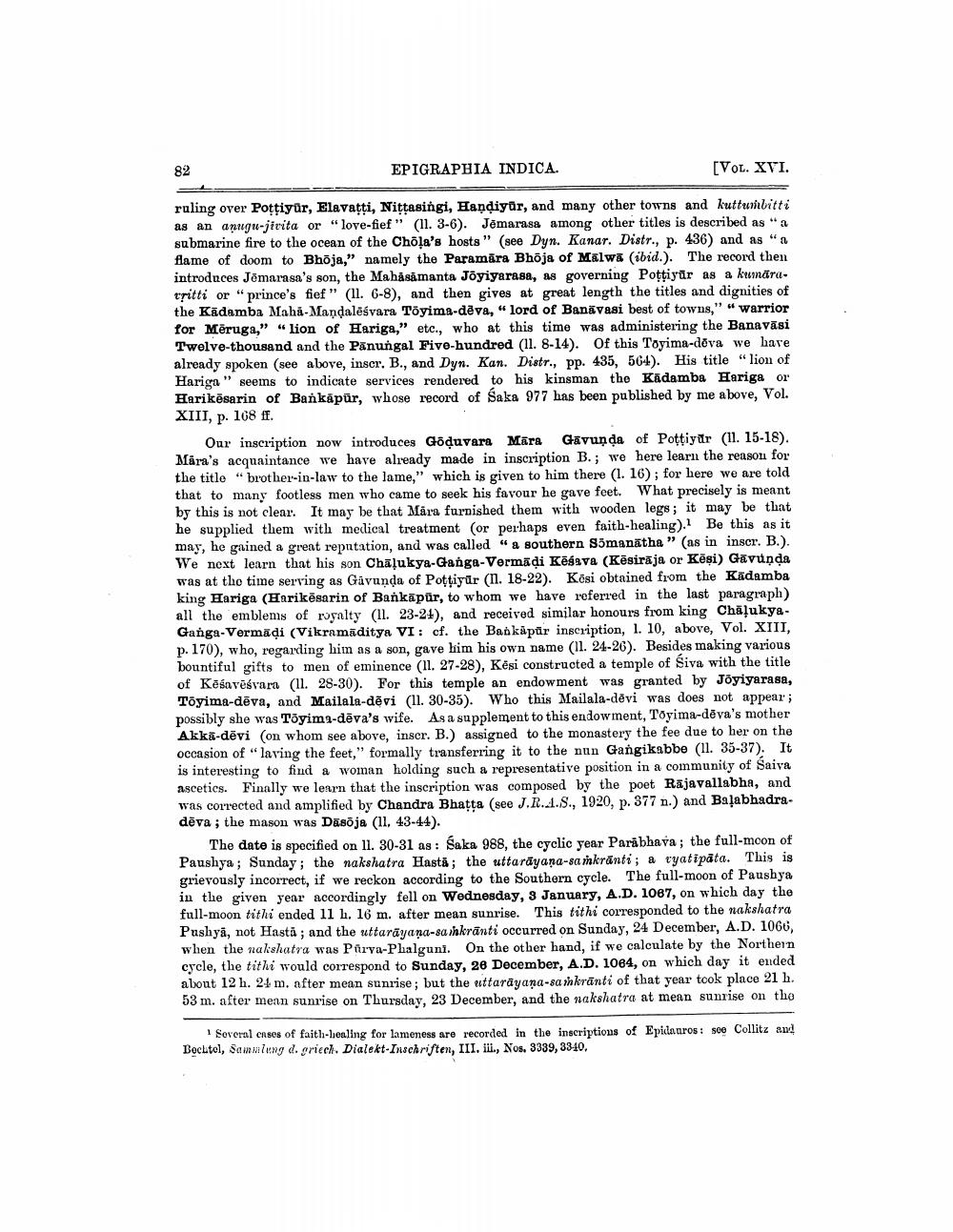________________
82
EPIGRAPHIA INDICA.
(VOL. XVI.
ruling over Pottiyur, Elavatti, Nittasingi, Handiyur, and many other towns and kuttunbitti as an anugu-jivita or "love-fief" (11. 3-6). Jēmarasa among other titles is described as a submarine fire to the ocean of the Chola's hosts" (see Dyn. Kanar. Distr., p. 436) and as "a flame of doom to Bhoja," namely the Paramāra Bhöja of Malwa (ibid.). The record then introduces Jēmarasa's son, the Mahåsamanta Jõyiyarasa, as governing Pottiyur as a keunära. tsitti or "prince's fief" (11. 6-8), and then gives at great length the titles and dignities of the Kādamba Mahi Mandalēśvara Toyima-dēva," lord of Banävasi best of towns," " warrior for Mēruga," " lion of Hariga," etc., who at this time was administering the Banavāsi Twelve-thousand and the Pānungal Five-hundred (11. 8-14). Of this Toyima-dēva we have already spoken (see above, inscr, B., and Dyn. Kan. Distr., pp. 435, 564). His title " lion of Hariga" seems to indicate services rendered to his kinsman the Kādamba Hariga or Harikēsarin of Bankāpūr, whose record of Saka 977 has been published by me above, Vol. XIII, p. 168 ff.
Our inscription now introduces Göduvara Māra Gāvunda of Pottiyur (11. 15-18). Mara's acquaintance we have already made in inscription B.; we here learn the reason for the title "brother-in-law to the lame," which is given to him there (1. 16); for here we are told that to many footless men who came to seek his favour he gave feet. What precisely is meant by this is not clear. It may be that Mára furnished them with wooden legs; it may be that he supplied them with medical treatment or perhaps even faith-healing). Be this as it may, he gained a great reputation, and was called "& southern S5manātha " (as in inscr. B.). We next learn that his son Chalukya-Ganga-Vermadi Kegava (Kēsirkja or Kēsi) Gāvunda was at the time serving as Gāvunda of Pottiyur (11. 18-22). Kēsi obtained from the Kadamba king Hariga (Harikësarin of Bankāpür, to whom we have referred in the last paragraph) all the emblems of royalty (11. 23-24), and received similar honours from king Chāļukya. Ganga-Vermadi (Vikramaditya VI: cf. the Bankāpür inscription, 1. 10, above, Vol. XIII, p. 170), who, regarding him as a son, gave him his own name (11. 24-26). Besides making various bountiful gifts to men of eminence (11. 27-28), Kësi constructed a temple of Siva with the title of Kēšavēśvara (11. 28-30). For this temple an endowment was granted by Jõgiyarasa, Toyima-dēva, and Mailala-dēvi (11. 30-35). Who this Mailala-devi was does not appear; possibly she was Tõyima-dēva's wife. As a supplement to this endowment, Toyima-dēva's mother Akka-dēvi (on whom see above, inscr. B.) assigned to the monastery the fee due to her on the occasion of "laving the feet," formally transferring it to the nun Gangikabbe (11. 35-37), It is interesting to find a woman holding such a representative position in a community of Saiva ascetics. Finally we learn that the inscription was composed by the poet Rajavallabha, and was corrected and amplified by Chandra Bhatta (see J.R.A.S., 1920, p. 377 n.) and Balabhadradēva ; the mason was Dasõja (11. 43-44).
The date is specified on 11. 30-31 as : Saka 988, the cyclic year Paribhava; the full-moon of Paushya; Sunday; the nakshatra Hasta; the uttarayana-sankranti; a ryatipāta. This is grievously incorrect, if we reckon according to the Southern cycle. The full-moon of Paushya in the given year accordingly fell on Wednesday, 3 January, A.D. 1067, on which day the full-moon tithi ended 11 h. 16 m. after mean sunrise. This tithi corresponded to the nakshatra Pushyā, not Hastă; and the uttarayana-sankrānti occurred on Sunday, 24 December, A.D. 1066, when the nakshatra was Parya-Phalguni. On the other hand, if we calculate by the Northern cycle, the tithi would correspond to Sunday, 28 December, A.D. 1084, on which day it ended about 12 h. 24 m. after mean sunrise; but the uttarayana-sankrānti of that year took place 21 h. 53 m. after menn sunrise on Thursday, 23 December, and the nakshatra at mean sunrise on the
Soveral chaos of faith-bealing for lameness are recorded in the inscriptions of Epidauros: soe Collitz aur! Bochtel, Sammlung d. grieck. Dialekt-Inschriften, III. iii., Nos. 3339, 3340.




